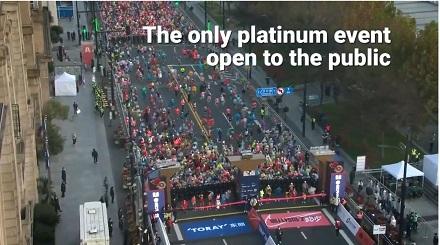

First, the London Marathon showed it was possible to host a world-class competitive event amid the COVID landscape. Now, the Shanghai Marathon has taken that one step further, hosting a whopping 9,000 runners, making it the biggest live event to be held since COVID hit our collective conscience – and weeks before a vaccine was expected to become available.
According to Endurance.Biz, this was the 25th running of the marathon. This was also the marathon’s first year as a Platinum Label road race event as listed by World Athletics (formerly known as the IAAF). Although most Platinum Label events worldwide were cancelled or limited solely to elite runners this year, the Shanghai Marathon, which took place on November 29, was a mass participation event.
In some ways, it looked exactly like any other marathon. There were 26 medical tents staffed by 200 professionals, along with 20 ambulances along the route. Xinhuanet News reported that 3,872 volunteers and almost 400 officials worked the course.
The two top finishers came from China with Jia Erenjia completing the course in two hours, 12 minutes and 44 seconds to win first place for the men, while Li Zhixuancrossed the finishing line with a result of 2:26:39 to take the women’s victory.
"After a long time of training and waiting, I finally took part in a race amid the pandemic. It was not easy, but I am happy to get this result," Jia told Xinhuanet.
The winners of the marathon received 150,000 yuan ($22,515), and those ranked second to eighth won 100,000 yuan ($15,239) to 20,000 yuan ($3,047), according to the competition rules released on the event's official website.
Most races of this level attract top international talent from around the globe; however, the Shanghai Marathon limited its entrants this year to avoid risk.
And make no mistake, there were plenty of other precautions in place. The race crowd of 9,000 was less than one-third of the typical registration (and a virtual event was offered for those who could not attend the live race). Instead of one mass start, participants were released in three waves of 3,000 each, and the route was configured to avoid crowding.
Other measures designed to reduce crowds were the elimination of the 10K and 5K races associated with the marathon as part of an overall running festival.
The success came from a long planning process.
"We initiated the whole pandemic control and prevention work as far back as May this year," Zhou Jin, of the event operator Donghao Lansheng Group, told CGTN News.
Organizers worked with health professionals to implement screening protocols to ensure that all the registered runners tested negative for COVID-19, and that they had not traveled to high-risk regions in the two weeks leading up to the marathon.
Volunteers were tested as well. Zhou noted that only those who had received the COVID-19 nucleic acid tests could work the event.
In deciding who could run, organizers had to inspect every entry, and to reject the applications of runners who, though eminently qualified, had lived in or traveled through regions classified as medium- to high-risk for the virus.
The Global Times noted that the event included a “circuit breaker mechanism,” which, if someone had tested positive but still ran the event, that runner would be stopped as quickly as possible.
“Moreover,” CGN News noted, “participants were asked to check their temperatures and report to the organizing committee every day 10 days. Those who failed the temperature test could not take part in the event.”
As runners completed the race, they were given a specific amount of time to cool down before being required to put on a mask supplied by staff. Volunteers were also at the ready with hand sanitizer and reminders about social distancing.
The Global Times concluded that the event would help create a positive outlook to the general public and that the world might be able to view it a "new start" in the post-coronavirus era of China, where the virus originated. And with other major Chinese-hosted events, such as the Formula 1 Chinese Grand Prix and the Rolex Shanghai Masters tennis tournament, having been cancelled earlier in the year, the marathon provided a refreshing change of pace.
Most Chinese cities have withstood the brunt of the COVID-19 pandemic during the recent National Day holidays, Zhang Wenhong, China's leading infectious disease specialist and head of the Shanghai COVID-19 medical team, told reporters prior to the event.
"The marathon will not be interrupted due to the pandemic, which I think is very encouraging to all our epidemic control personnel and people in China, and to the epidemic control measures that we have been adhering to all the time," Zhang said.

